tires LEXUS LS430 2006 Owners Manual
[x] Cancel search | Manufacturer: LEXUS, Model Year: 2006, Model line: LS430, Model: LEXUS LS430 2006Pages: 419, PDF Size: 11.19 MB
Page 4 of 419
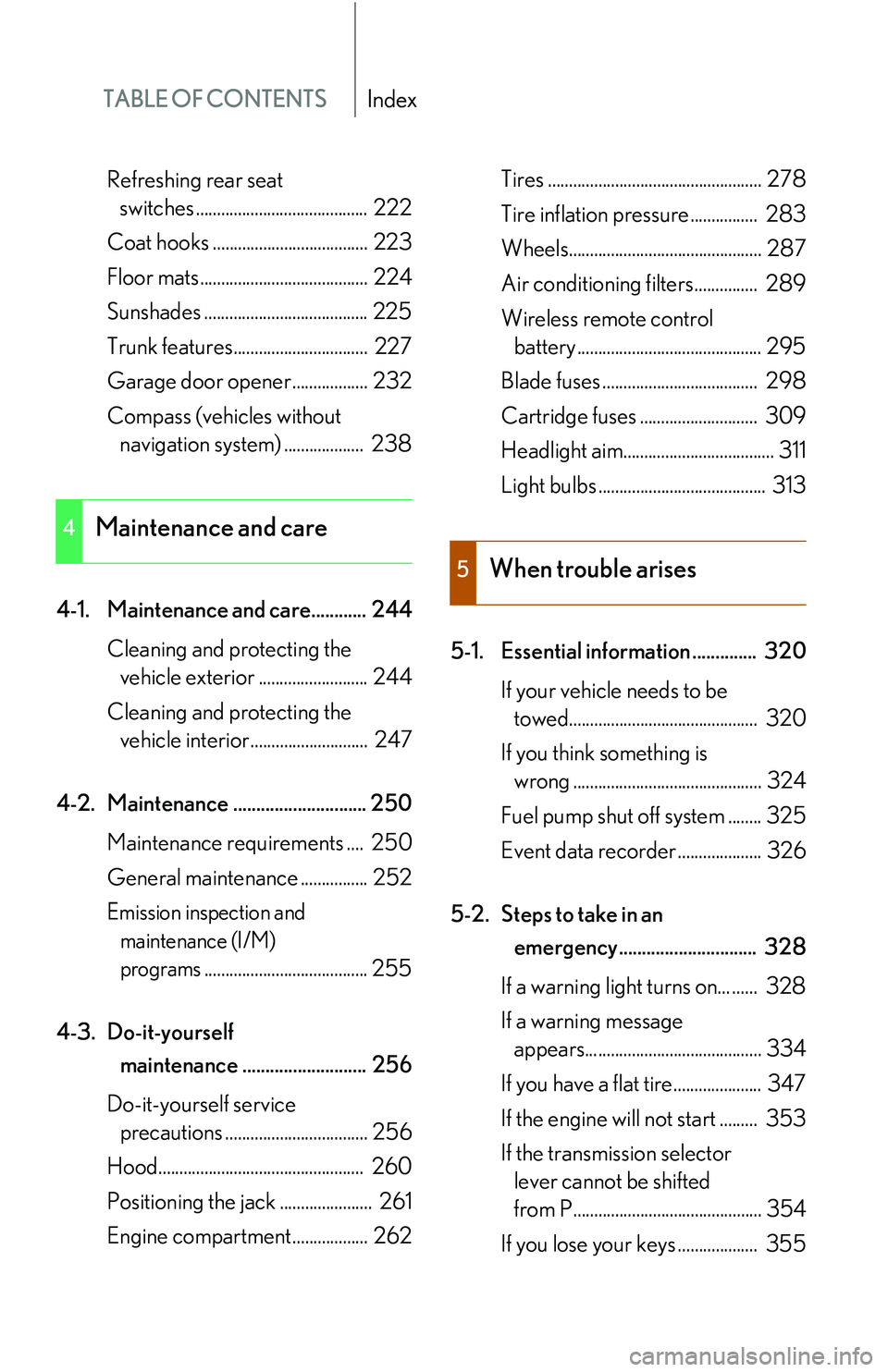
TABLE OF CONTENTSIndex
Refreshing rear seat
switches ......................................... 222
Coat hooks ..................................... 223
Floor mats........................................ 224
Sunshades ....................................... 225
Trunk features................................ 227
Garage door opener .................. 232
Compass (vehicles without
navigation syst em)
................... 238
4-1. Maintenance and care............ 244 Cleaning and protecting the
vehicle exterior .......................... 244
Cleaning and protecting the
vehicle interior............................ 247
4-2. Maintenance ............................. 250 Maintenance requ irements
.... 250
General maintenance ................ 252
Emission inspection and
maintenance (I/M)
programs....................................... 255
4-3. Do-it-yourself
maintenance ........................... 256
Do-it-yourself service
precautions .................................. 256
Hood................................................. 260
Positioning the jack ...................... 261
Engine compartment.................. 262 Tires ................................................... 278
Tire inflation pressure................ 283
Wheels.............................................. 287
Air conditioning filters............... 289
Wireless remote control
battery ............................................ 295
Blade fuses ..................................... 298
Cartridge fuses ............................ 309
Headlight aim.................................... 311
Light bulbs ........................................ 313
5-1. Essential information .............. 320 If your vehicle needs to be
towed............................................. 320
If you think something is
wrong ............................................. 324
Fuel pump shut off system ........ 325
Event data recorder .................... 326
5-2. Steps to take in an
emergency .............................. 328
If a warning light turns on... ...... 328
If a warning message
appears.......................................... 334
If you have a flat tire..................... 347
If the engine will not start ......... 353
If the transmission selector
lever cannot be shifted
from P............................................. 354
If you lose your keys ................... 355
4Maintenance and care
5When trouble arises
Page 158 of 419
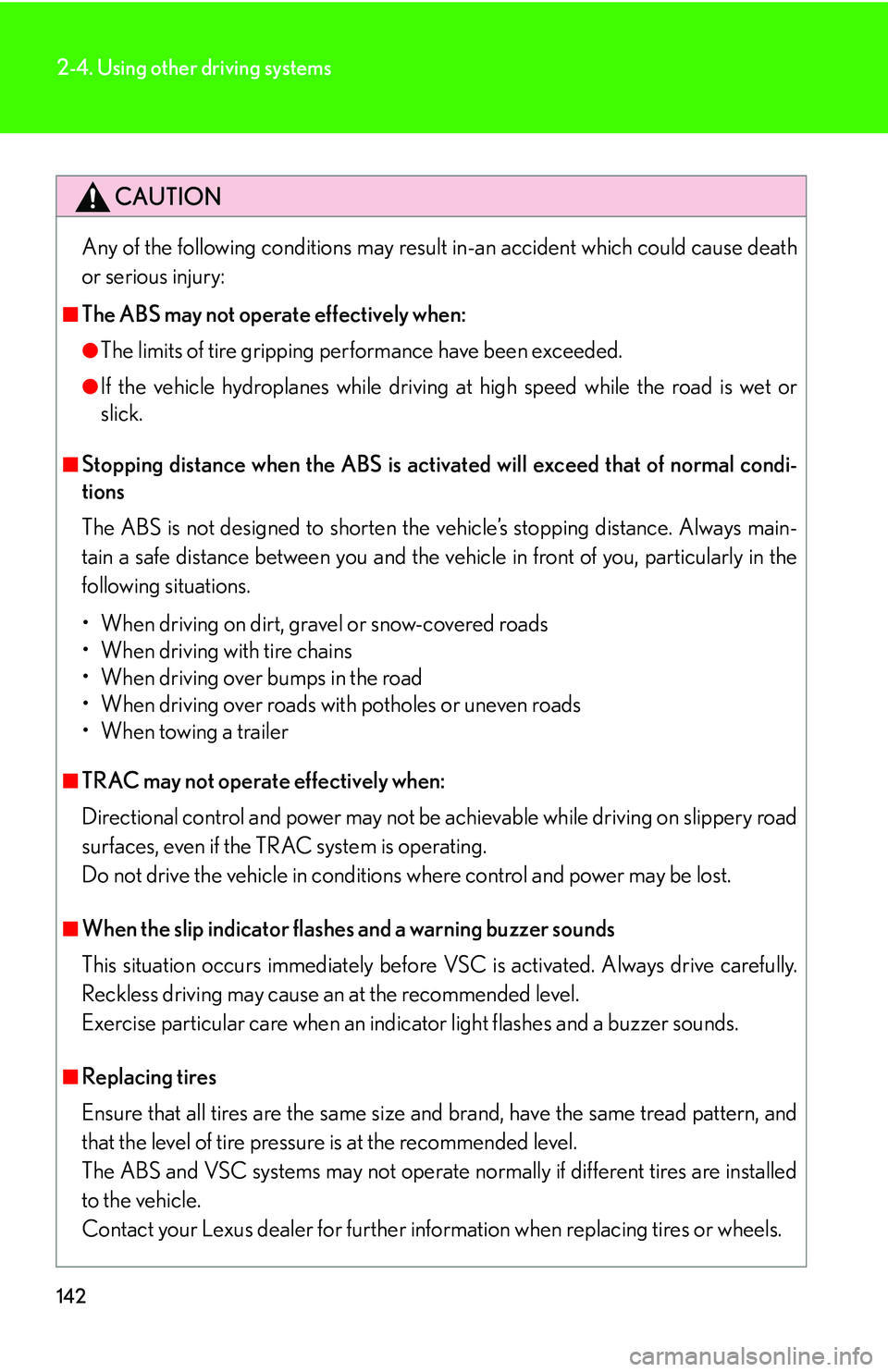
142
2-4. Using other driving systems
CAUTION
Any of the following conditions may result in-an accident which could cause death
or serious injury:
■The ABS may not operate effectively when:
●The limits of tire gripping performance have been exceeded.
●If the vehicle hydroplanes while driving at high speed while the road is wet or
slick.
■Stopping distance when the ABS is activated will exceed that of normal condi -
tions
The ABS is not designed to shorten the v
ehicle’s stopping distance. Always main -
tain a safe distance between you and the vehicle in front of you, particularly in the
fo
llowing situations.
• When driving on dirt, gravel or snow-covered roads
• When driving with tire chains
• When driving over bumps in the road
• When driving over roads with potholes or uneven roads
• When towing a trailer
■TRAC may not operate effectively when:
Directional control and power may not be ac hi
evable while driving on slippery road
surfaces, even if the TRAC system is operating.
Do not drive the vehicle in conditions where control and power may be lost.
■When the slip indicator flashe s and a warning buzzer sounds
This situation occurs immediately before VSC is activated. Always drive carefully.
R
eckless driving may cause an at the recommended level.
Exercise particular care when an indicator light flashes and a buzzer sounds.
■Replacing tires
Ensure that all tires are the same size an d
brand, have the same tread pattern, and
that the level of tire pressure is at the recommended level.
The ABS and VSC systems may not operate no rmal
ly if different tires are installed
to the vehicle.
Contact your Lexus dealer for further info rmati
on when replacing tires or wheels.
Page 164 of 419
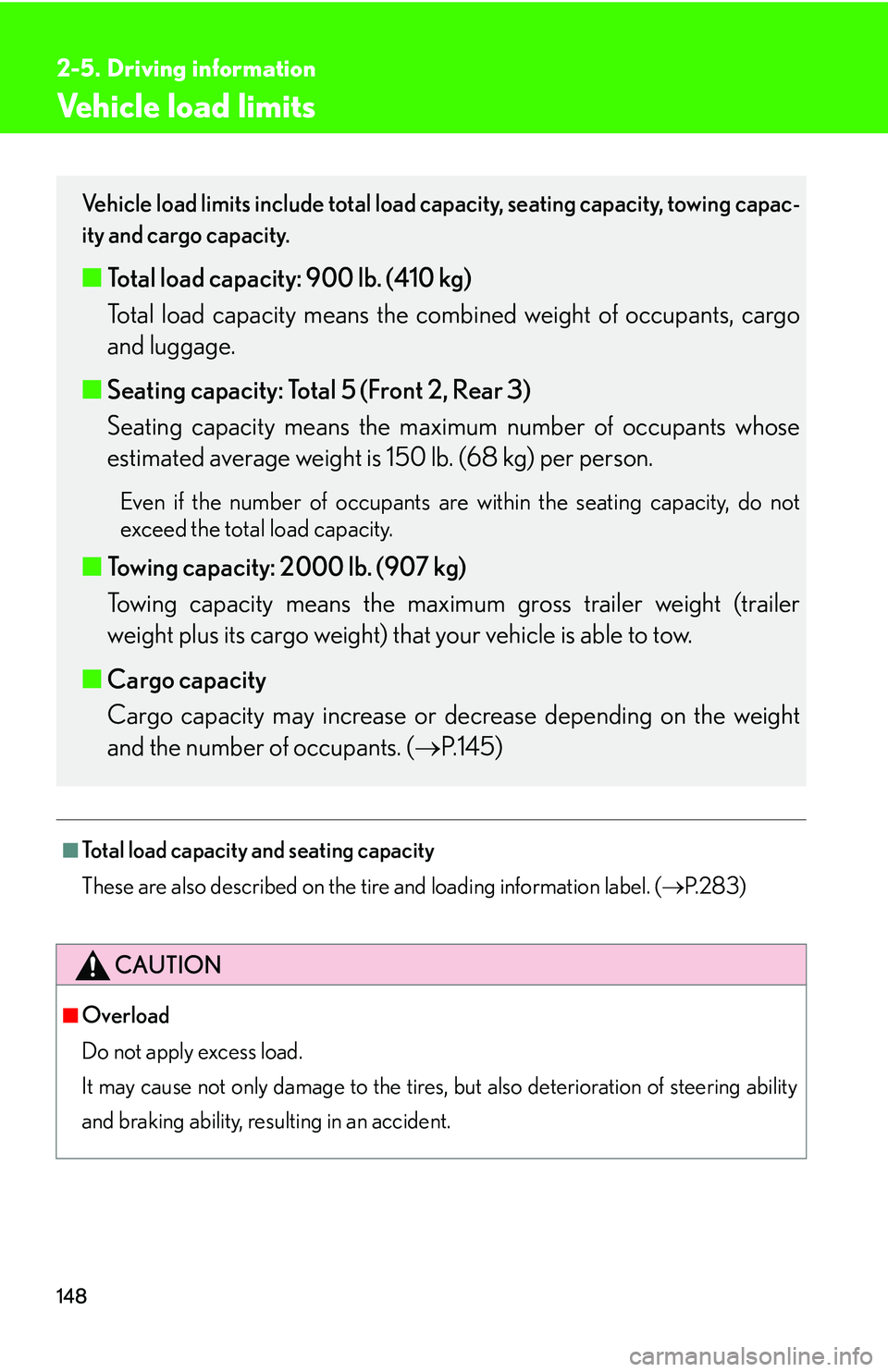
148
2-5. Driving information
Vehicle load limits
■Total load capacity and seating capacity
These are also described on the tire and loading information label. ( P. 2 8 3 )
CAUTION
■Overload
Do not apply excess load.
It may cause not only damage to the tires, but also
deterioration of steering ability
and braking ability, resu lting in an accident.
Vehicle load limits include total load ca pacity, seating capacity, towing capac-
ity and cargo capacity.
■ Total load capacity: 900 lb. (410 kg)
Total load capacity means the comb ined w
eight of occupants, cargo
and luggage.
■ Seating capacity: T
otal 5 (Front 2, Rear 3)
Seating capacity means the maxi mum number of occupants whose
estimated a
verage weight is 150 lb. (68 kg) per person.
Even if the number of occupants ar e within the seating capacity, do not
exceed the total load capacity.
■ Towing capacity: 2000 lb. (907 kg)
Towing capacity means the maximum gross trailer weight (trailer
w
eight plus its cargo weight) that your vehicle is able to tow.
■ Car
go capacity
Cargo capacity ma y incr
ease or decrease depending on the weight
and the number of occupants. ( P.145 )
Page 165 of 419
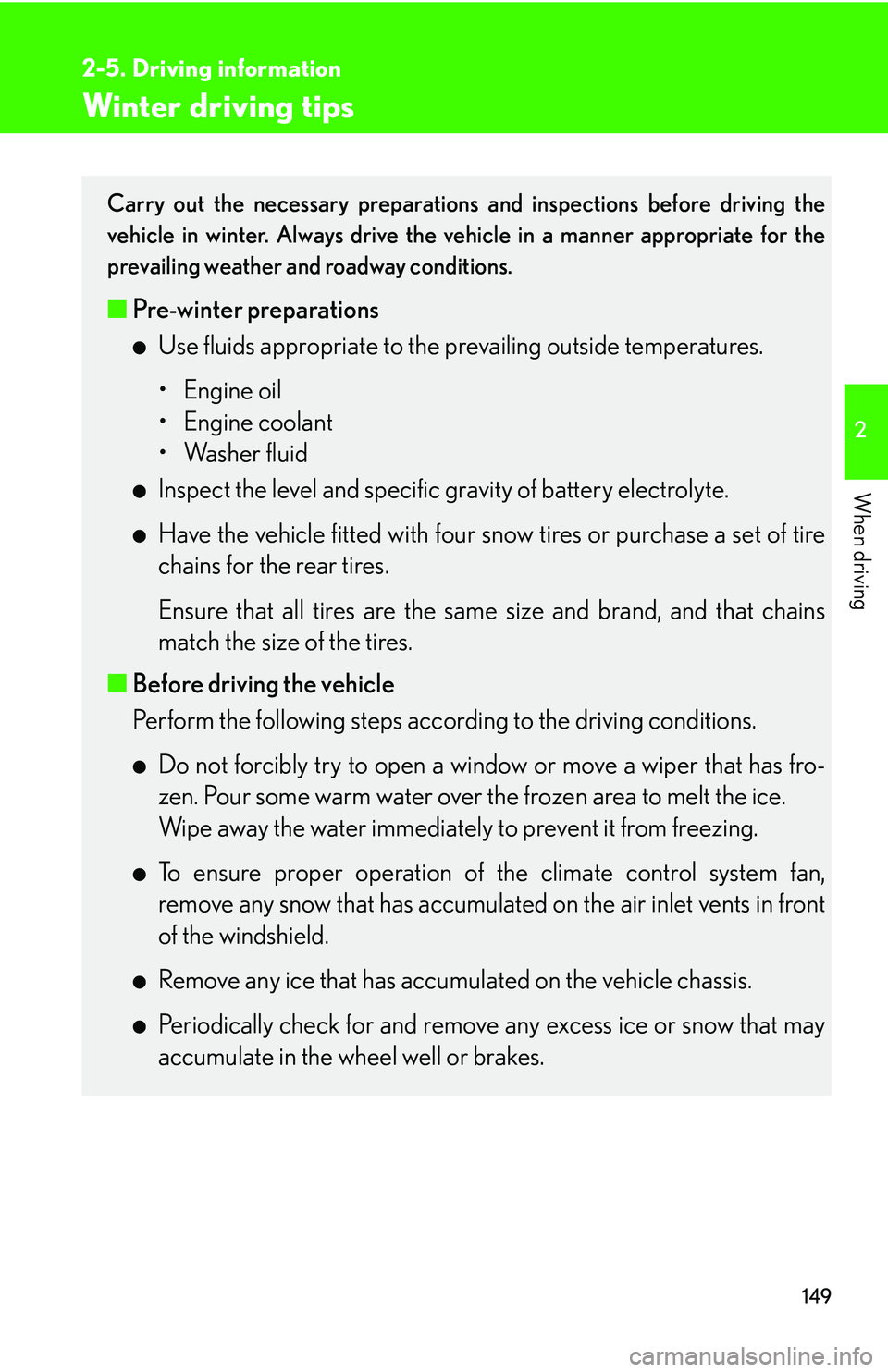
149
2-5. Driving information
2
When driving
Winter driving tips
Carry out the necessary preparations and inspections before driving the
vehicle in winter. Always drive the vehicle in a manner appropriate for the
prevailing weather and roadway conditions.
■ Pre-winter preparations
●Use fluids appropriate to the p revailing outside temperatures.
• Engine oil
• Engine coolant
• Washer fluid
●Inspect the level and specific gravity of battery electrolyte.
●Have the vehicle fitted with four sno w tires or purchase a set of tire
chains for the rear tires.
Ensure that all tires are the same si
ze and brand, and that chains
match the size of the tires.
■ Befor
e driving the vehicle
Perform the following steps acco r
ding to the driving conditions.
●Do not forcibly try to open a window or move a wiper that has fro-
zen. Pour some warm water over the frozen area to melt the ice.
Wipe away the water immediately to pr
event it from freezing.
●To ensure proper operation of the climate control system fan,
remove any snow that has accumulated on the air inlet vents in front
of the windshield.
●Remove any ice that has accumulated on the vehicle chassis.
●Periodically check for and remove any excess ice or snow that may
accumulate in the wheel well or brakes.
Page 166 of 419
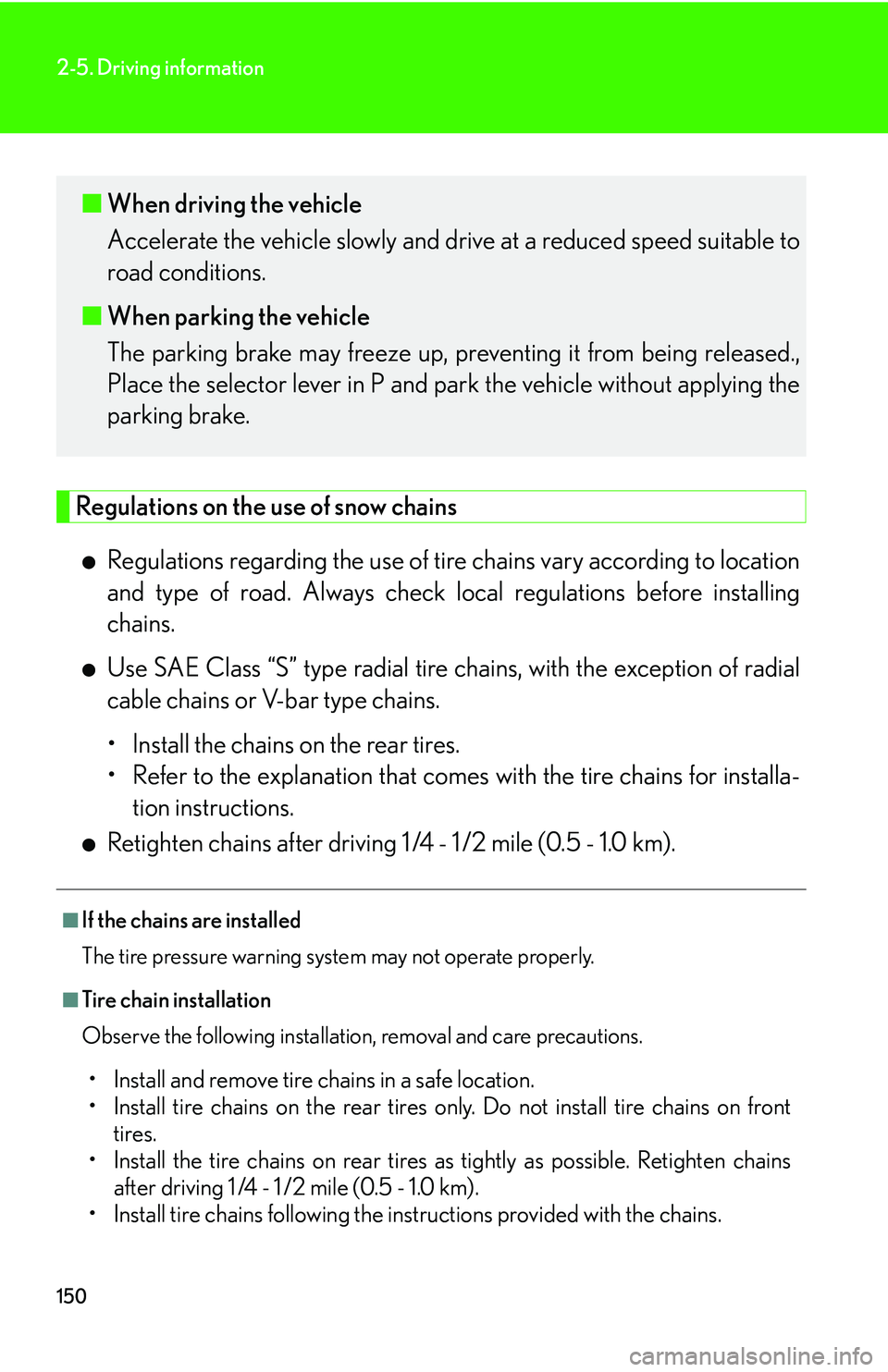
150
2-5. Driving information
Regulations on the use of snow chains
●Regulations regarding the use of tire chains vary according to location
and type of road. Alwa ys check local regulations before installing
chains.
●Use SAE Class “S” type radial tire chains, with the exception of radial
cable chains or V-bar type chains.
• Install the chains on the rear tires.
• Refer to the explanation that comes with the tir
e chains for installa-
tion instructions.
●Retighten chains after driving 1 /4 - 1 /2 mile (0.5 - 1.0 km).
■If the chains are installed
The tire pressure warning system may not operate properly.
■Tire chain installation
Observe the following installation, removal and care precautions.
• Install and remove tire chains in a safe location.
• Install tire chains on the rear tires only. Do not install tire chains on front tir
es.
• Install the tire chains on rear tires as tightly as possible. Retighten chains af
ter driving 1 /4 - 1 /2 mile (0.5 - 1.0 km).
• Install tire chains following the inst ructions pr
ovided with the chains.
■When driving the vehicle
Accelerate the vehicle slowly and driv e at a reduced speed suitable to
road conditions.
■ When parking the v
ehicle
The parking brake may freeze up, prev enting it fr
om being released.,
Place the selector lever in P and park the vehicle without applying the
parking brake.
Page 167 of 419
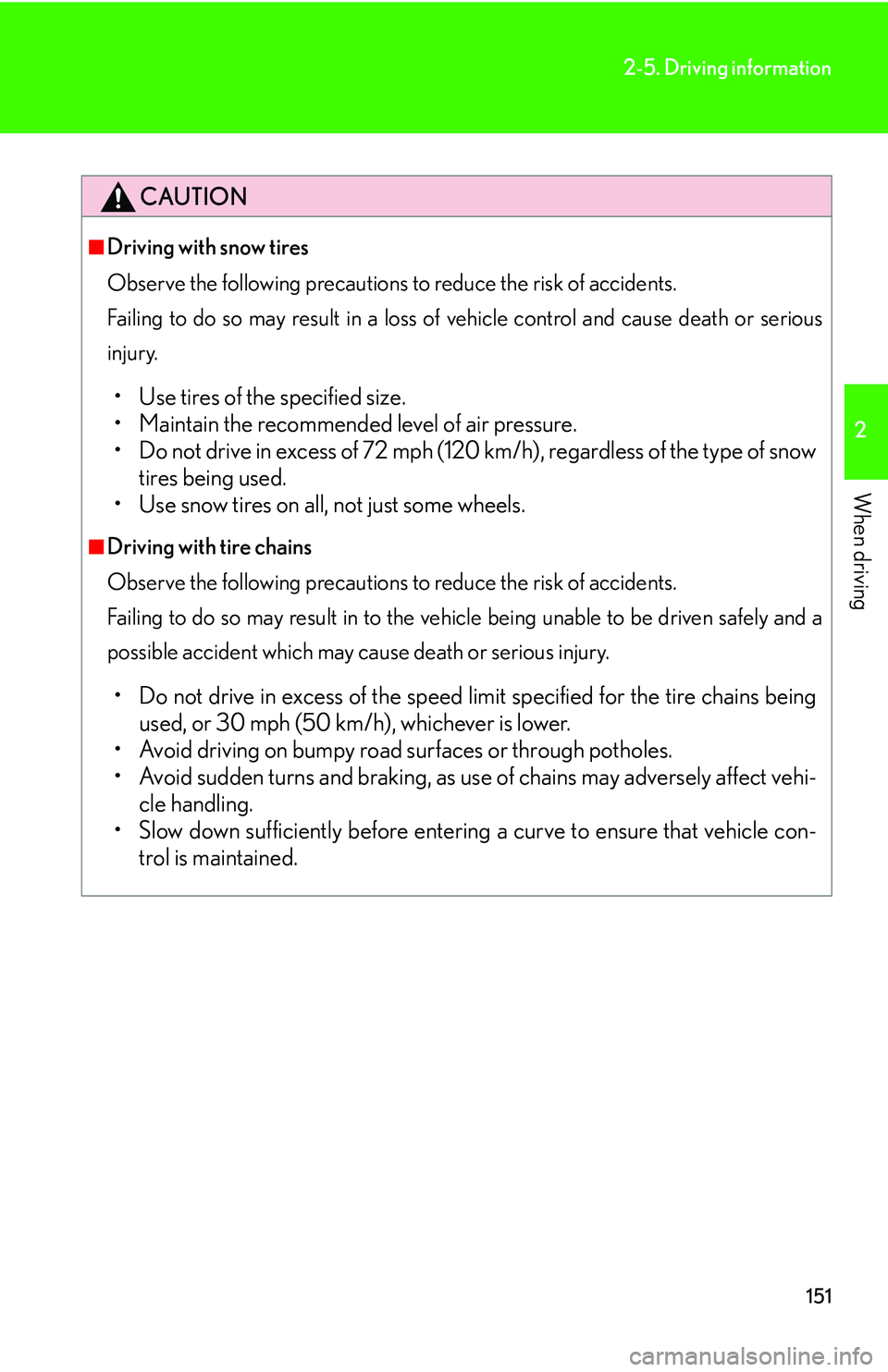
151
2-5. Driving information
2
When driving
CAUTION
■Driving with snow tires
Observe the following precautions to reduce the risk of accidents.
Failing to do so may result in a loss of vehicle control and cause death or serious
injur
y.
• Use tires of the specified size.
• Maintain the recommended level of air pressure.
• Do not drive in excess of 72 mph (120 km/h), regardless of the type of snow tir
es being used.
• Use snow tires on all, not just some wheels.
■Driving with tire chains
Observe the following precautions to reduce the risk of accidents.
Failing to do so may result in to the vehicle being unable to be driven safely and a
p
ossible accident which may cause death or serious injury.
• Do not drive in excess of the speed limit specified for the tire chains being
used, or 30 mph (50 km/h), whichever is lower.
• Avoid driving on bumpy road s
urfaces or through potholes.
• Avoid sudden turns and braking, as us e of chains may a
dversely affect vehi-
cle handling.
• Slow down sufficiently before entering a curve to ensure that vehicle con -
trol is maintained.
Page 170 of 419
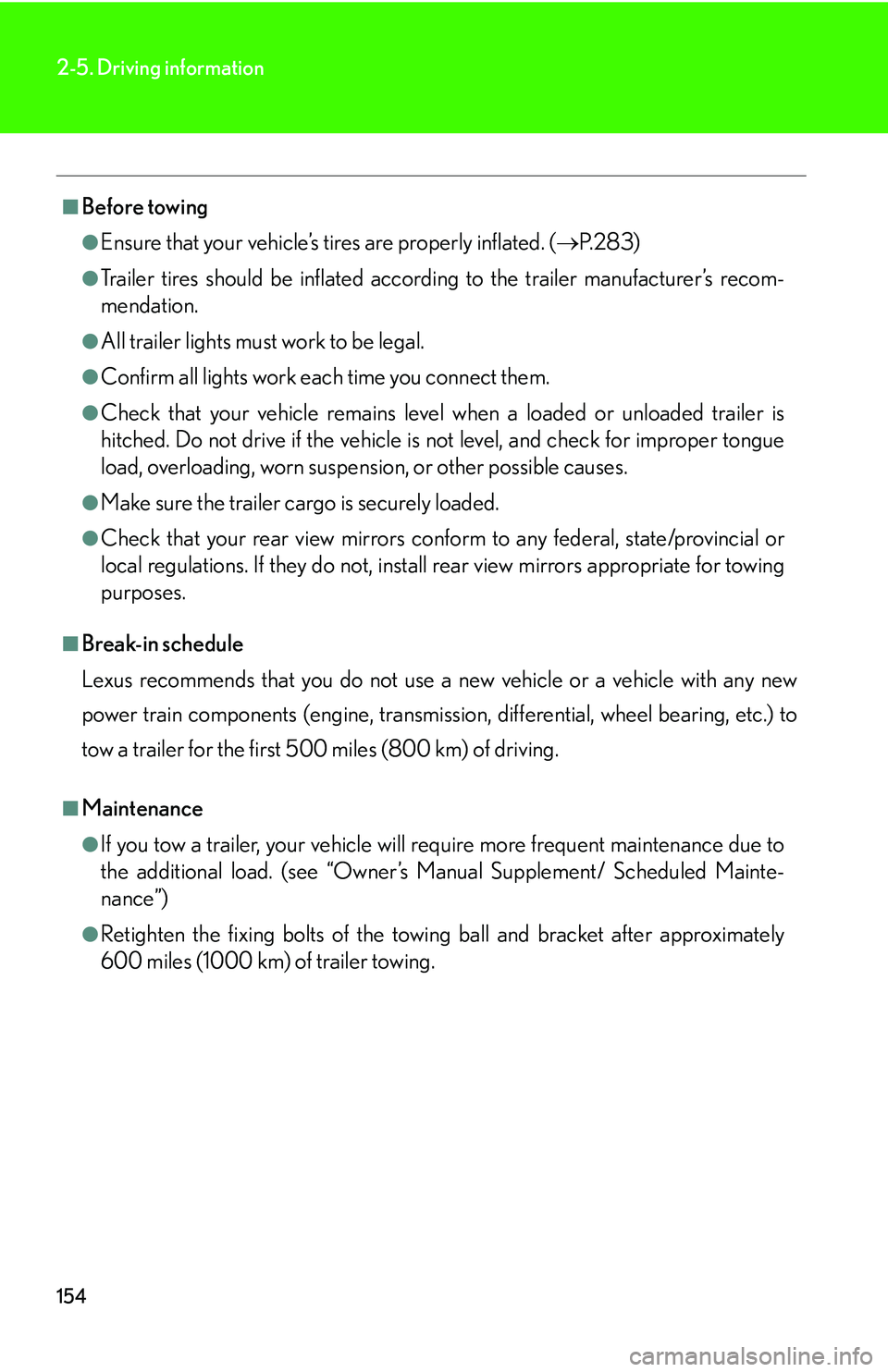
154
2-5. Driving information
■Before towing
●Ensure that your vehicle’s tires are properly inflated. (P.283 )
●Trailer tires should be inflated according to the trailer manufacturer’s recom -
mendation.
●All trailer lights must work to be legal.
●Confirm all lights work each time you connect them.
●Check that your vehicle remains level when a loaded or unloaded trailer is
hitched. Do not drive if the vehicle is not level, and check for improper tongue
load, overloading, worn suspension, or other possible causes.
●Make sure the trailer cargo is securely loaded.
●Check that your rear view mirrors conform to any federal, state/provincial or
local regulations. If they do not, instal l rear view mirrors appropriate for towing
purposes.
■Break-in schedule
Lexus recommends that you do not use a new vehicle or a vehicle with any new
p
ower train components (engine, transmissi on, differential, wheel bearing, etc.) to
tow a trailer for the first 500 miles (800 km) of driving.
■Maintenance
●If you tow a trailer, your vehicle will require more frequent maintenance due to
the additional load. (see “Owner’s Manual Supplement/ Scheduled Mainte -
nance”)
●Retighten the fixing bolts of the towing ball and bracket after approximately
600 miles (1000 km) of trailer towing.
Page 172 of 419
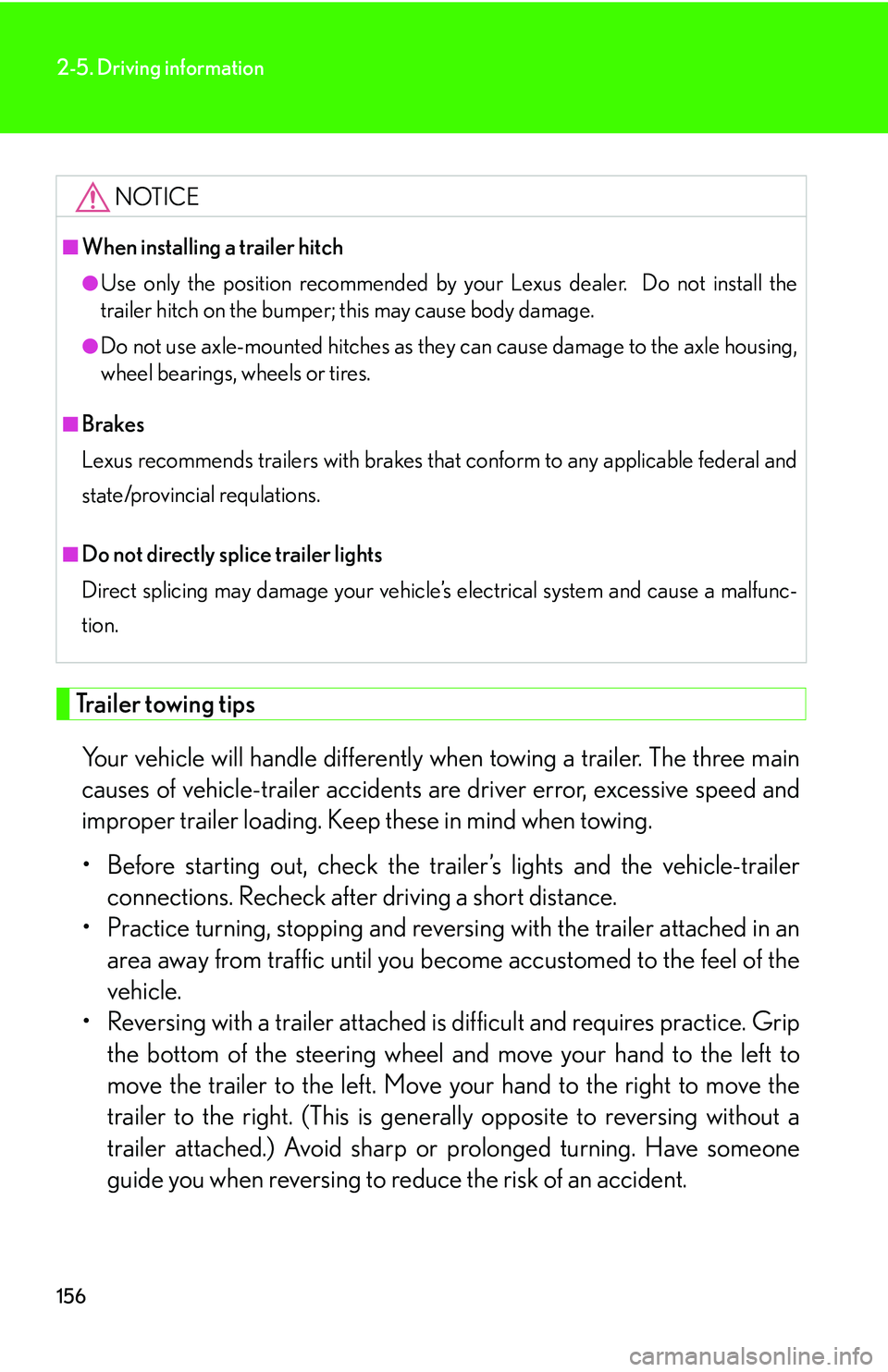
156
2-5. Driving information
Trailer towing tips
Your vehicle will handle differently when towing a trailer. The three main
causes of vehicle-trailer accidents are driver error, excessive speed and
improper trailer loading. Keep these in mind when towing.
• Before starting out, check the tra iler
’s lights and the vehicle-trailer
connections. Recheck after driving a short distance.
• Practice turning, stopping and reversi ng with the tr
ailer attached in an
area away from traffic until you be come accustomed to the feel of the
vehicle.
• Reversing with a trailer attached is dif
ficult and requires practice. Grip
the bottom of the steering wheel and move your hand to the left to
move the trailer to the left. Move yo ur hand to the right to move the
trailer to the right. (This is gene rally opposite to reversing without a
trailer attached.) Avoid sharp or prolonged turning. Have someone
guide you when reversing to redu ce the risk of an accident.
NOTICE
■When installing a trailer hitch
●Use only the position recommended by your Lexus dealer. Do not install the
trailer hitch on the bumper; this may cause body damage.
●Do not use axle-mounted hitches as they can cause damage to the axle housing,
wheel bearings, wheels or tires.
■Brakes
Lexus recommends trailers with brakes that conform to any applicable federal and
sta
te/provincial requlations.
■Do not directly splice trailer lights
Direct splicing may damage your vehicle’s electrical system and cause a malfunc -
tion.
Page 259 of 419
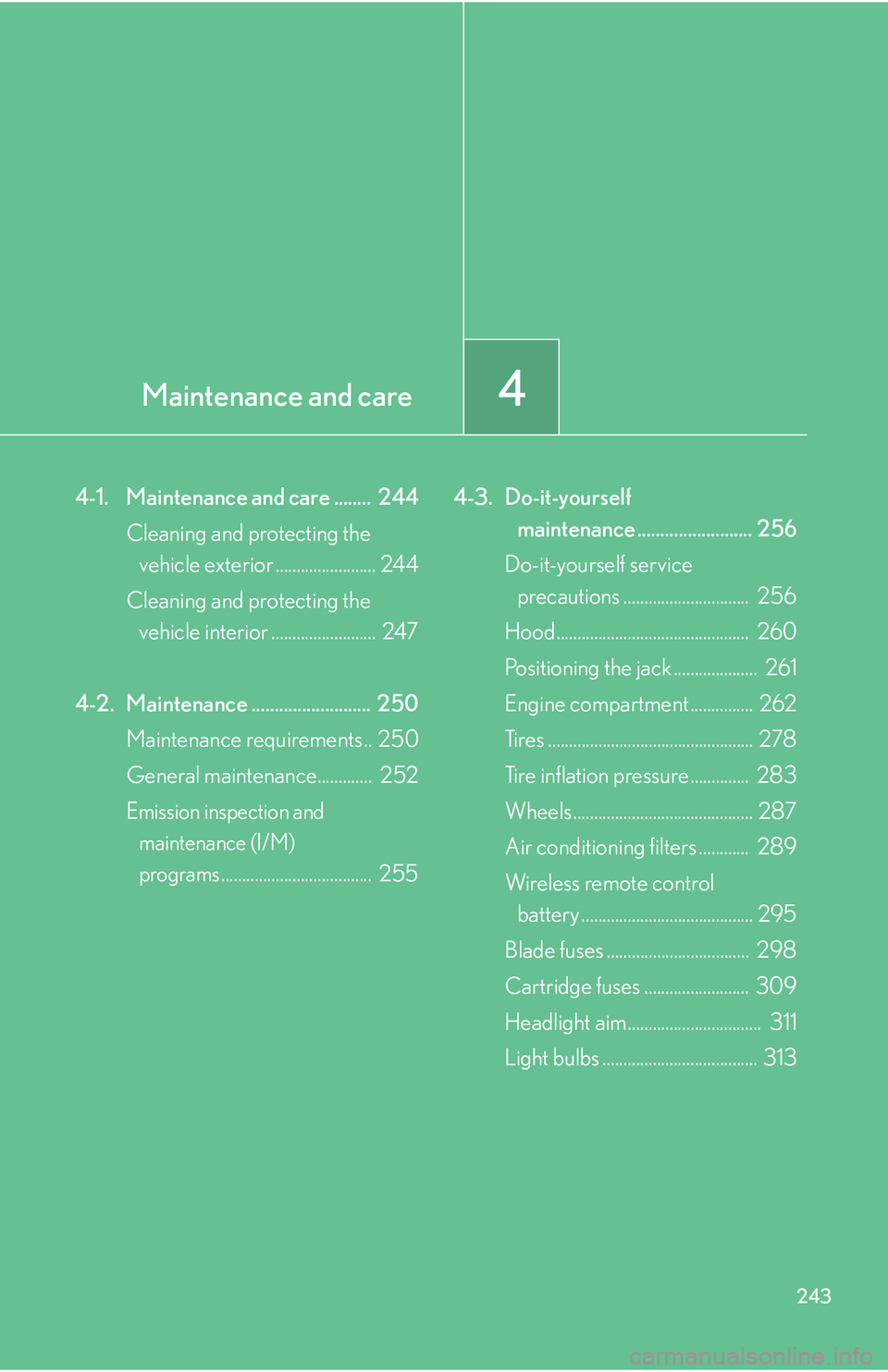
4Maintenance and care
243
4-1. Maintenance and care ........ 244
Cleaning and protecting the vehicle exterior ........................ 244
Cleaning and protecting the vehicle interior ......................... 247
4-2. Maintenance .......................... 250 Maintenance requirements.. 250
General maintenance............. 252
Emission inspection and
maintenance (I/M)
programs.................................... 255 4-3. Do-it-yourself
maintenance ......................... 256
Do-it-yourself service
precautions .............................. 256
Hood.............................................. 260
Positioning the jack .................... 261
Engine compartment ............... 262
Tires ................................................. 278
Tire inflation pressure .............. 283
Wheels ........................................... 287
Air conditioning filters
............ 289
Wireless remote control battery ......................................... 295
Blade fuses .................................. 298
Cartridge fuses ......................... 309
Headlight aim................................ 311
Light bulbs ..................................... 313
Page 270 of 419
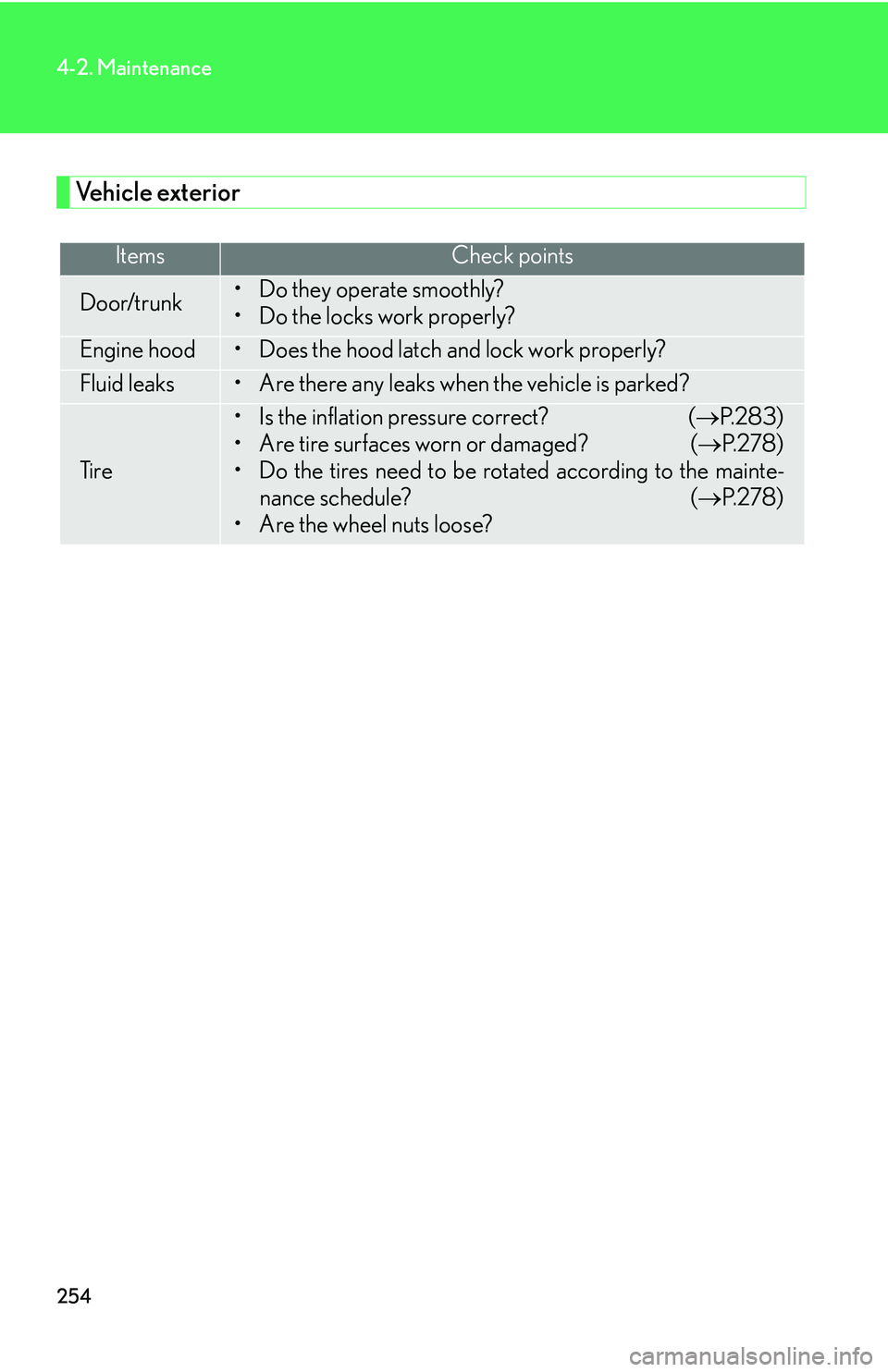
254
4-2. Maintenance
Vehicle exterior
ItemsCheck points
Door/trunk• Do they operate smoothly?
• Do the locks work properly?
Engine hood• Does the hood latch and lock work properly?
Fluid leaks• Are there any leaks when the vehicle is parked?
Ti r e
• Is the inflation pressure correct? ( P. 2 8 3 )
• Are tire surfaces worn or damaged? ( P. 2 7 8 )
• Do the tires need to be rotated according to the mainte- nance schedule? ( P. 2 7 8 )
• Are the wheel nuts loose?